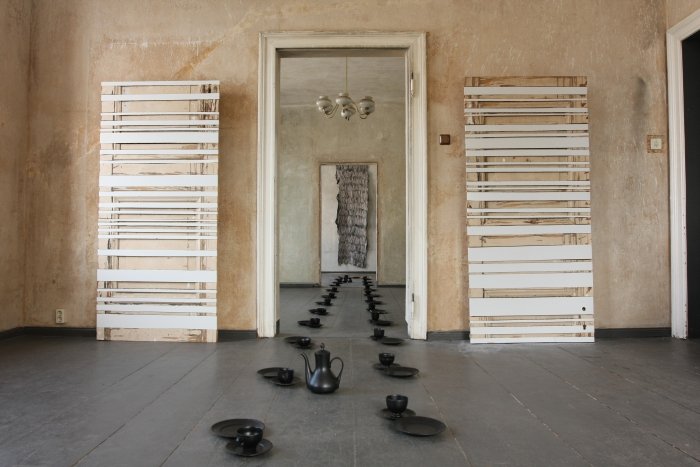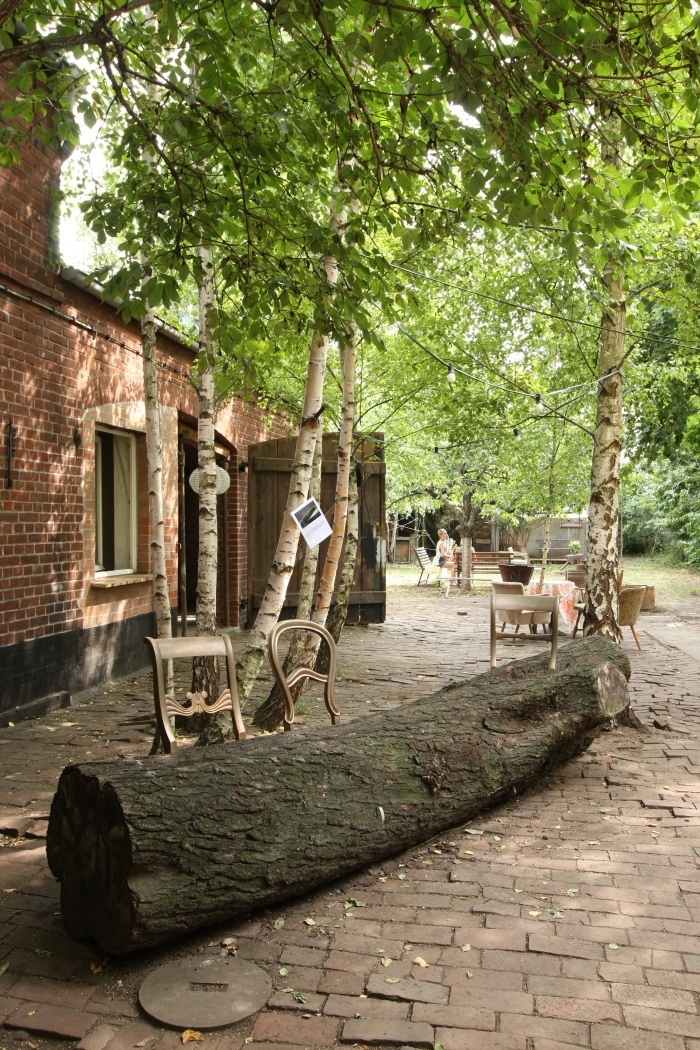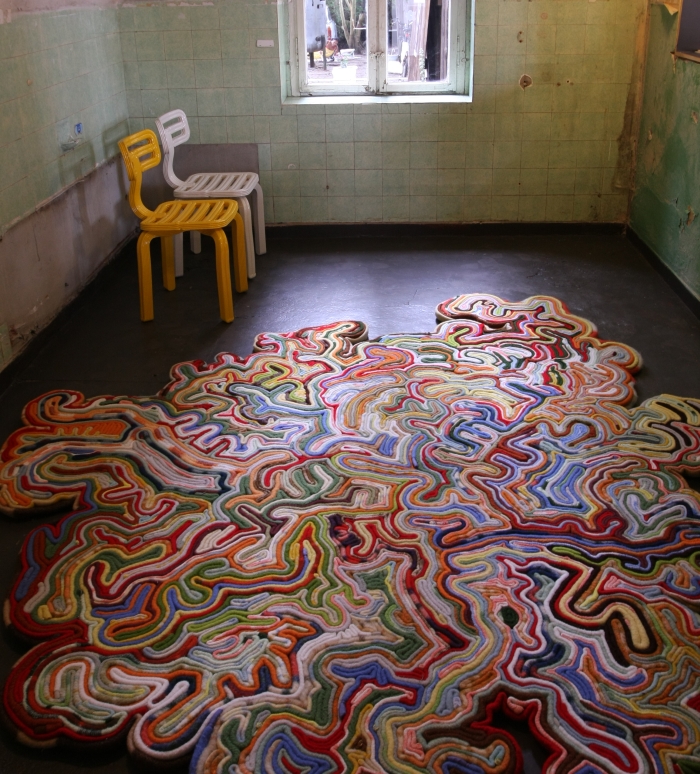In 2011 a group of Dutch artists and designers established the Orangemann Trust and set about converting an old, abandoned house in the centre of Oranienbaum into a gallery for contemporary art and design.
That Oranienbaum is a village of some 3000 inhabitants situated 150 kilometres south of Berlin, 80 kilometres north of Leipzig and 4 light years from the next railway station, the location could appear somewhat questionable.
Could.
Were it not for the fact that modern Oranienbaum was acquired in 1660 by the House Oranien-Nassau and that in 1683 the Dutch royal family began with the construction of a palace and landscaped garden complex in the middle of the village. A palace and landscaped garden complex that quickly established itself as a popular summer and hunting residence of the Dutch royals and their cohorts.
Then came the war. Weimar Republic. Another war. DDR. German unification. And with it the chance to renovate the crumbling and dilapidated shell that had been Schloss Oranienbaum.
In 2012 with the renovations almost complete Schloss Oranienbaum hosted "Dutch Design – Huis van Oranje", an exhibition devoted to over 400 years of Dutch creativity.
And 500 metres down the road the Orangemann Trust opened the inaugural summer exhibition in the newly established Ampelhaus Gallery.
2014 sees Ampelhaus present "Unter Zwischen im Ampelhaus", the gallery's third summer exhibition and a show which ably demonstrates why Ampelhaus is well on its way to becoming just as popular a summer destination as the neighbouring Schloss once was.

Following on from their 2012 exhibition “Use it Again” which explored reusing and recycling in various contexts and 2013′s “King Size: Art and Design fit for a King” with its more regal perspective on the same subjects, the 2014 exhibition “Unter Zwischen im Ampelhaus” moves the discussion on to add more considered reflections on aesthetics, memory, semantics and emotions in context of salvaged and recycled objects.
Something perhaps best demonstrated by Studio Makkink & Bey's truly monstrous Tree Trunk Bench: a work which is also one of the more apposite exhibits, being as it is an example of reuse created by a Dutch designer in Oranienbaum. Just a dozen years before Ampelhaus arrived.
On a visit to Oranienbaum in 1999 Jurgen Bey witnessed the large numbers of fallen trees lying around the grounds of Schloss Oranienbaum; their similarity to park benches being inescapable and irresistible Jurgen Bey created bronze backrests modelled on historic chair designs found in the Schloss to complete the impression. Last year, by good fortune, the Ampelhaus team observed a tree being felled across the road from them, secured the trunk and so this year can present a Tree Trunk Bench in, near as damn it, its original location.

The very first Tree Trunk Bench was created in context of the Studio Droog project "Couleur Locale", a project which also included works by Hella Jongerius, Marcel Wanders and Martí Guixé, an enviable collection of some of the most promising young Dutch based designers of that period.
Unter Zwischen im Ampelhaus in many ways mirrors and updates that roster, presenting as it does works by some of the more interesting and progressive young designers and artists the Netherlands currently has to offer.
Dirk Vander Kooij, for example, is represented with his 2013 Chubby Chair, a work that takes the extreme 3D printing concept developed in his Endless project to create a recycled polystyrene chair with the most delightfully endearing and engaging cartoon-esque form, while Amsterdam based Pepe Heykoop is represented with two projects, the anarchic 2012 Bits of Wood which combines waste wood and waste tin to create new products, plus two objects from his ongoing Skin Collection series in which he covers old, neglected objects in leather waste thus giving a new life, purpose and aesthetic charm to both.
In addition Unter Zwischen im Ampelhaus features works by a further 20 or so artists and designers including, amongst others, Olaf Mooij, Isaac Monté, Bram Braam and Tejo Remy & René Veenhuizen, whose Accidental Carpet created from cut-offs and loose ends of old wool blankets graces the space like some slowly melting Keith Haring painting. One could almost say Keith Haring meets Salvador Dali. In a wool carpet.
But its not all Dutch designers and artists. There is, for example, the installation Geheel gebroken by Bielefeld born, Berlin based designer Birgit Severin in which old, slightly damaged porcelain is coated in black rubber, thus, apparently, preserving the past in a stable and secure form. However, despite its new shroud of invincibility the porcelain remains as fragile and transient as ever. Drop it and it will still break. You just won't see it.
Or Korean designer Bora Hong with her Cosmetic Surgery Kingdom project, a project in which she transposes the world of plastic surgery on to the world of design. Cosmetic Surgery Kingdom is and was a far reaching, multi-faceted project, on show at Ampelhaus is but one part of that whole, namely an "Eames DCW" and a "Rietveld rood-blauwe stoel" each created from the de-constructed, disjointed remnants of another, less illustrious chair, a chair that wanted/needed "plastic surgery" to become interesting, attractive, illustrious. But is it better than it was? Or just more familiar than it was?
Both Bora Hong and Birgit Severin are, it must be noted, Design Academy Eindhoven alumni, and so while not Dutch themselves, there is an Oranje link.

Little remains in Ampelhaus from past exhibitions. For Unter Zwischen im Ampelhaus all is refreshingly, and fittingly, new. Including the extension of the exhibition space into the courtyard, stables and outhouses. The one obvious retention from years past being Leerdam artist Oscar Prinsen's 2013 intervention "Überraschendes Gespräch", in which two holes were cut in the ground floor ceiling and a very high chair placed under each hole, thus allowing visitors the chance to engage in a conversation across the expanse of the first floor. The first floor itself remaining out of bounds for visitors: Überraschendes Gespräch allowing access and interaction. For Unter Zwischen im Ampelhaus Oscar Prinsen has gone down, cutting a whole in the ground floor floor through which one reaches a stool in the cellar, and thus, apparently, opening up the cellar for the visitor. Just as Überraschendes Gespräch achieved with first floor. Except Oscar Prinsen doesn't open up the cellar. Quite apart from placing the visitor in a cage akin to that used when diving with sharks, the floor of the Ampelhaus cellar has been littered with 1080 ceramic flowers by Rotterdam based artist Onno Poiesz. Delicate, fragile ceramic flowers which although, meadow like, invite one to lie down and dwell a while, paradoxically also stop you doing just that. Consequently you are left alone, isolated and with a tantalising view of a freedom you could have.
With its mix of art and design Unter Zwischen im Ampelhaus isn't an especially easy exhibition. There are easy, very accessible, moments, moments where it is very clear what the designer or artist wants to demonstrate/explain/bemoan; but there are also works that require a lot more time, a lot more effort and a lot more consideration. Time, effort and consideration that the relaxed atmosphere in the Ampelhaus and the open exhibition design concept positively support and encourage.
And away from the theoretical, philosophical aspects Unter Zwischen im Ampelhaus can also be enjoyed at a very basic level, Martijn Hesseling's art work, for example, arising from a fascinating mix of newspaper and varnish, Ron van der Ende's mesmerising bas-reliefs or Claudy Jongstra's wool, silk and linen wall hangings being objects that one can simply sit back and enjoy.
Something we can strongly recommend.
Unter Zwischen im Ampelhaus can be viewed at Ampelhaus, Brauerstraße 33, 06785 Oranienbaum until Saturday September 20th
Full details, in Dutch and German, can be found at http://ampelhaus.nl